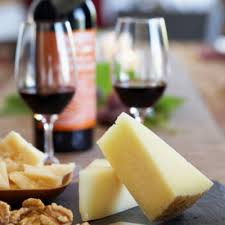best wine to have with cheese

Wine and cheese are two of life’s great culinary pleasures, and finding the perfect match can be a delicious endeavor. As with any wine and food pairing, there are a number of considerations, such as texture, acidity, fat and tannin. Rather than complicating the topic with exotic matches like Garrotxa and Meursault, we have broken the art of wine and cheese pairing down, so you can create your own. Wine and Cheese Pairings The wine-cheese pairing possibilities are endless, but to simplify the strategy, we can divide cheese into four major categories: Bloomy: Creamy, decadent cheeses, with a soft rind. Hard: Stiff cheeses, which are often sharp and/or salty. They can also be aged. Blue: Pungent, often salty cheeses, with a blue tinge. Fresh: Soft, often spreadable cheeses that can be tangy or mild. They are not usually aged. If you have a specific cheese in mind, first contemplate the category it belongs to. You can then consult our wine and cheese pairing examples for ideas.

Just as with any food pairing, it helps to think of either complementary or contrasting flavors. A lush wine works well with a triple-cream cheese, while an acidic wine will cut the cheese’s sweetness.
buy rare wine onlineAs you begin to experiment, taste the cheese first by itself, to get a sense of its character, and then put another bite into your mouth with some wine to see how they mingle.
food and wine best vegan recipesMany experts say that white tends to pair better with cheese, but a light-bodied red and cheese pairing is still possible.
buy wine and spirits online Wine and Cheese Pairing Examples: Preparing a Wine and Cheese Party What better way to taste a variety of pairings then to throw a wine and cheese party?

Purchase a few different cheeses from a cheese shop or gourmet store with a well-equipped storage facility. Discuss your plans with the cheesemonger and ask for recommendations. You can get creative with cheese place cards or purchase a nifty slate cheese tray, which allow you to etch cheese names in chalk. Lastly, be sure to serve the wine and cheese at their proper temperatures, so their flavors can emerge. Serve white wine at 45°F, red wine at 60°F and remove the cheese from the refrigerator 30 to 60 minutes prior to serving. Wine and Cheese Party Menu A great wine and cheese party offers pairing selections with varied flavor profiles. Display the options in a circle and have your guests start with lighter wines and fresher cheeses and move clockwise toward the ones that have sharpness and depth. To simplify, you could also choose a flexible wine that pairs with a wide range of cheeses. A lean red, such as Gamay or Pinot Noir, could serve as a perfect starting point. Your guests can taste that wine with each cheese and then rank the pairings.

It's New Year's Eve, and your guests are about to come tumbling in. You set out bowls of salty snacks and a grand platter of cheeses. There's creamy white chèvre, a Stilton, some Brie, nutty aged Gruyère, tangy Vermont cheddar, and a splurge-worthy chunk of 4-year Gouda. With a flourish you top the platter with fruits and nuts just as the doorbell rings. It's time to start popping corks. There's Champagne, of course, and let's see—what else? What wine goes best with all those cheeses? The good news is that your guests will be thrilled no matter what you pour. The bad news is: it's complicated. Pairing wine and cheese is harder than you'd think. That's because there isn't just one kind of wine and one kind of cheese. Cheeses vary in moisture content, fat content, texture, flavor. Wines, too, vary in acidity, sweetness, body, and structure. Fortunately, a few basic guidelines will bring match-making success, and by midnight your cheese and wine will be arm and arm singing Auld Lang Syne.

All of cheese-dom lies along a continuum from fresh through hard-aged. Young fresh cheeses have a high water content and a milky and delicate texture. As a cheese ages, a process called affinage, the moisture in its body slowly evaporates, leaving behind fat and protein. Since fat and protein carry flavors, older cheeses tend to be more rich and savory. In addition to drying and concentrating the cheese, age also introduces new flavors. Bloomy-rind cheeses like Brie remain gooey and spreadable, but have picked up earthy notes from a few months in the cave. Older cheeses like Gruyère and Emmental acquire nutty flavors. Blue cheeses develop pungency from the mold in their veins. Washed-rind cheeses like Époisses earn a funky, bacon-y redolence that you either love or hate. Like cheeses, wines also run the gamut from delicate to bold, and their depth and complexity can correlate with their age, too. Young wines are fresh and spirited, with lively aromas and bright flavors of fruits, flowers, citrus, herbs, or spice.

Wines that have spent time in cask or bottle have had a chance to knit together and acquire more nuance. In addition to their primary fruit flavors, they take on secondary notes of oak, toast, earth, oxidation, minerals, umami, and more. Like cheeses, these wines tend to be more complex and savory than their younger counterparts. We can readily see how young cheeses might partner best with wines that are juicy, fruity, fresh and spirited—sparkling wines, crisp whites, dry rosés, and reds with good acidity and sprightly fruit. Older cheeses would need wines with more body and complexity. The very oldest cheeses, those that are the most savory and rich and nutty, pair best with wines that have ample body and structure, and maybe oxidative notes, too. Putting this all together, we arrive at the first rule of wine and cheese pairing: Pair by flavor intensity, and consider intensity's correlation with age. But age definitely isn't the only factor to keep in mind. A cheese's texture, saltiness, and pungency also influence a wine pairing, as do the wine's structure and sweetness.

Here are a few other notes to keep in mind: Tannic red wines are terrific with rich, aged cheeses, because their tannins literally bind to protein and fat, cleaning your palate after each bite. But the same process makes tannic wines feel far too astringent with young cheeses; they tie up what little fat's available, leaving you with a chalky sensation and a metallic aftertaste. If you must serve red wine with young cheeses, reach for one low in tannin, like Beaujolais or sparkling red Lambrusco. Sweet wines beautifully balance the saltiest cheeses like hard Grana, blue cheese, aged Gouda, or feta. The salt in the cheese heightens the perception of sweetness in the wine, so a wine that's already headed in that direction makes for a breezy pairing. Cheese loves fruit and nuts. There's a reason we adorn cheese plates with fresh fruits, dried fruits, and nuts. The juicy, tangy fruits go well with young cheeses like Brie. Sweet dried fruits are wonderful with salty cheeses like Stilton.

Buttery, bitter nuts are tasty with rich Cheddar. From fruity to sweet to nutty to tannic, these same pairing principles apply to wines, too. When in doubt, try to imagine which food would pair best with a cheese, and let that guide you toward a wine. Texture: complement or contrast. Rich, creamy cheeses blend seamlessly with buttery, oaky white wines, creating a truly harmonious palate sensation. But contrast can be welcome, too. The bubbles in sparkling wines pose a nice counterpoint to a rich cheese, scrubbing your tongue clean and making you want another bite. That's why Camembert and Champagne are a classic combination. What grows together goes together. Following this old adage, French goat cheese from the Loire is gorgeous with Loire Sancerre; the grassy, minerally qualities of the wine perfectly complement these flavors in the cheese. Red Burgundy's a natural with Époisses, a creamy cow's milk cheese whose rind is washed with a brandy made from Burgundian grape skins.

Manchego, a hard Spanish sheep's milk cheese, is great with both Sherry and buxom, grippy Monastrell from southern Spain. Matching by region doesn't always work flawlessly—I wouldn't serve fresh Loire goat cheese with a tannic Loire Cabernet Franc—but pairing by terroir can be a great place to start. Here it is, an easy guide to pairing wine and cheese. Find each cheese by type below, then pick a wine from the recommended list to find pairing nirvana. Fresh and soft cheeses love crisp whites, dry rosés, sparkling wines, dry aperitif wines, and light-bodied reds with low tannins. Wines with apple, berry, stone fruit, tropical, melon, or citrus flavors work best. Avoid big, tannic red wines like Malbec, Cabernet Sauvignon, Bordeaux, and Bordeaux blends. Cheeses: Ricotta, Mozzarella, Burrata, Chèvre, Feta, Halloumi, Brie, Camembert, Brillat-Savarin, Crottin, Bûcheron Pair with: Riesling (dry to sweet), Gewürztraminer, Moscato, Champagne, Cava, Chablis, Chenin Blanc, Pinot Gris, Pinot Grigio, Albariño, Grüner Veltliner, unoaked Chardonnay, Sauvignon Blanc, Provençal rosé, Beaujolais, Lambrusco, White Port, Fino sherry

These cheeses have a firmer texture and stronger flavors. They need medium-bodied whites, fruity reds, vintage sparkling wine, and aperitif wines that offer a balance between acidity, fruit, and tannin. Cheeses: Havarti, Edam, Emmental, Gruyère, Jarlsberg, young Cheddar, Monterey Jack, Manchego, Tomme d'Alsace Pair with: Chardonnay, white Burgundy, white Bordeaux, Pinot Blanc, Viognier, white Rhône blends, Riesling (off-dry), Gewürztraminer, Champagne, red Burgundy, Pinot Noir, Beaujolais, Dolcetto, Barbera, Zinfandel, Merlot, vintage Port, young Tawny Port, Amontillado sherry Stinky cheeses call for light-bodied wines with demure aromatics that complement rather than compete. Cheeses: Époisses, Taleggio, Morbier Pair with: Gewürztraminer, Riesling, Sauternes, red Burgundy, Pinot Noir Blue cheeses need wines with both oomph and sweetness to balance their bold flavors and usually very salty, savory body. Cheeses: Stilton, Gorgonzola, Roquefort, Cambozola, Bleu d'Auvergne

Pair with: red Port, Tawny Port, Sauternes, Oloroso sherry, Banyuls, Recioto, Tokaji Harder cheeses love full-bodied whites and tannic reds. Their nuttiness also works with oxidative wines like sherry, and their saltiness makes them terrific with sweet wines. Cheeses: Aged Cheddar, Cheshire, Comté, aged Gruyère, aged Gouda, Pecorino, Manchego, Asiago, Parmigiano Reggiano Pair with: Aged white Burgundy or Bordeaux, white Rhône blends, sweet Riesling, Viognier, vintage Champagne, Vin Jaune, red Burgundy, red Bordeaux, Cabernet Sauvignon, Barolo, Barbaresco, Nebbiolo, Petite Sirah, California red blends, red Rhône blends, Zinfandel, red Port, Tawny Port, Madeira, Sauternes, Oloroso sherry. It's fun to open a range of bottles to sample with your cheese assortment, but if you must pour a single wine with a mixed plate of cheeses, try Riesling, especially off-dry. The wine is low in alcohol, but its acidity, sweetness, tropical fruits, and mineral backbone let it partner broadly.